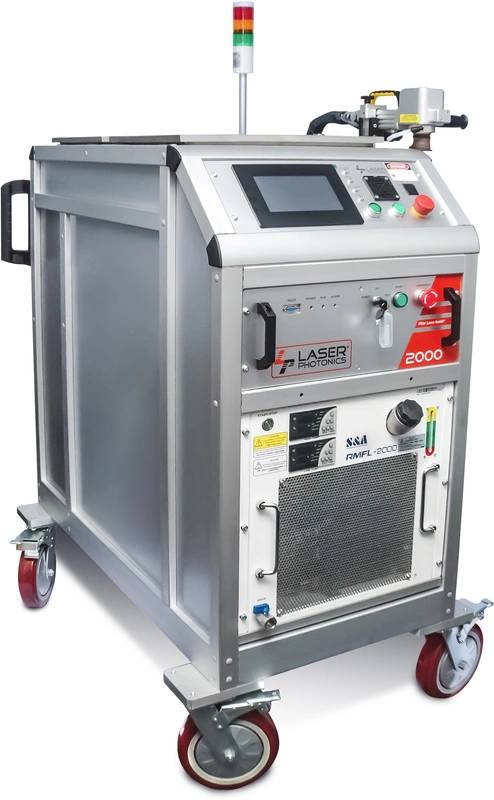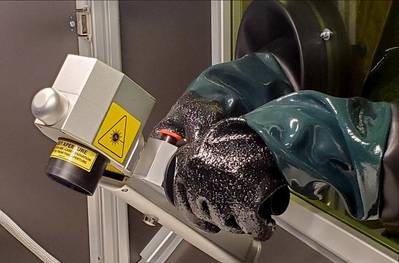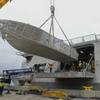Clean Technology Lasers: A New Tool to Remove Corrosion and Scale
Laser systems quickly remove corrosion and scale from metal surfaces with less preparation and mess than traditional techniques.
In the maritime industry, corrosion and scale (where rust penetrates a metal surface) can quickly become an issue in an outdoor, salt sea spray laden environment. When sea spray evaporates, it leaves salt behind, leading to saltwater staining and accelerated corrosion.
So, most shipbuilders as well as those responsible for maintenance and repair understand the value of treating metal surfaces to remove corrosion, scale and saltwater staining, which is vital to maintain essential interior and exterior components such as engines, generators, fuel pumps, winches, anchoring chains, latches, door hinges and locks. This is necessary to preserve not only function but also prevent further corrosion and deterioration including possible premature failure.
Unfortunately, traditional techniques used for this purpose such as sandblasting and chemical stripping are often messy and require expensive consumables as well as substantial time for preparation and cleanup. Additionally, sandblasting and chemical stripping may not be feasible to clean, maintain or recondition many of the ship’s interior and exterior spaces. These methods are also drawing scrutiny from regulators like the EPA and OSHA since they can pose risks to applicators and the environment.
Although manual methods of cleaning and removal are available, such as chipping and using wire brushes and grinders, these are very labor intensive and time consuming.
Today, a more effective alternative is utilizing industrial-grade, precision laser-based systems that can remove corrosion and scale with a high-energy laser beam that leaves the substrate unaffected. The technology can also be used for selective cleaning and even de-painting on access points and service latches when required. Preparation and cleanup time are minimal, and the low-maintenance equipment can last decades.
“Many people are unfamiliar with the use of lasers to pretreat metal surfaces,” said Vincent Galiardi, owner of Galiardi Laser Clean, a surface cleaning operator based in St. Charles County, Mo. “When I do a demonstration, at first the people in attendance are skeptical. But after I use the laser to treat a small area, everyone starts talking and getting excited. By the end, when I let them try the equipment, everyone is having a good time and saying how great the laser works.”
Given its effectiveness treating metal surfaces, industrial laser systems are increasingly being used at shipyards, shipbuilding berths and even aboard ships. Technicians can use mobile handheld units, or if needed the systems can be integrated into automated inline processing lines. Citing advantages in safety and efficiency, Galiardi said laser cleaning is poised to disrupt the surface treatment market across more sectors.
 (Photo: Laser Photonics)
(Photo: Laser Photonics)
Resolving conventional cleaning limitations
To treat metal surfaces, sandblasting or chemical stripping are traditionally used as industrial cleaning processes.
Sand blasting: Abrasive sandblasting involves forcefully projecting a stream of abrasive particles onto a surface, usually with compressed air or steam. The silica sand used in abrasive blasting typically fractures into fine particles and becomes airborne, which can cause serious or fatal respiratory disease.
When workers inhale crystalline silica, the lung tissue reacts by developing fibrotic nodules and scarring around the trapped silica particles, causing a fibrotic lung condition called silicosis. Estimates indicate that more than 1 million U.S. workers are at risk of developing silicosis and that more than 100,000 of these workers are employed as sandblasters.
In addition, particles are generated during abrasive blasting that further contribute to respiratory problems and other harmful health effects.
“When sand or any other media is used to knock off particles from a substrate, there is always a byproduct that has the potential to become airborne and inhaled,” Galiardi said.
“Industry has needed a cleaner, safer surface pre-treatment solution for a very long time,” Galiardi added. “Sandblasting is inherently unsafe for operators. The silica glass used in sandblasting is toxic. An operator must wear a full HEPA suit when sandblasting to avoid breathing in particulates.”
Sandblasting also is time-consuming to clean up since the sand essentially scatters everywhere, even though it is usually considered a “fast” cleaning method.
Chemical stripping: With chemical stripping, harsh, even toxic chemicals are used to strip metal-based objects of rust, paint and contaminants to bare metal. However, for operators, exposure to corrosive acids and noxious chemical fumes is inherently dangerous. The process can also be time-consuming to prepare the proper chemical bath, achieve the required level of cleaning, and dispose of the waste. In addition, disposing of toxic chemicals is costly and closely regulated by agencies like OSHA and the EPA.
Safe, effective laser cleaning
Laser-based systems have significant advantages over these traditional methods, including ease of use in which an operator simply points and clicks a high-energy laser beam at the surface. The substrate is not affected by the laser, and the systems do not create any mess or byproducts. The approach is eco-friendly, energy-efficient, and completes the job in half the time of traditional methods when preparation and cleanup are considered.
“In our experience, laser cleaning is as fast at removing rust or old coatings as other methods, but without the same amount of cleanup,” Galiardi said. “When we treat a surface with lasers, any fumes or dislodged particulate is extracted into a HEPA filter and the job is done. There is no media [sand, chemicals] to replenish or clean up.”
Galiardi Laser Clean uses laser systems made by Orlando, Fla.-based Laser Photonics, a provider of patented industrial grade CleanTech laser systems for cleaning and surface conditioning. The American-made systems function either as mobile standalone units or can be integrated into production lines.
The laser systems are available in portable and stationary models ranging from 50 to 3,000 watts (a 4,000-watt version is in development) with chamber sizes from 3’ x 3’ in size to 6’ x 12’. The systems can also be installed in manufacturing lines in cabinets or operated by a robotic arm.
In the shipbuilding industry, operators are utilizing the industrial grade laser systems to maintain a wide range of vital interior and exterior equipment. Operators are using CleanTech systems to smooth surfaces and remove rust and scale from engines, generators, fuel pumps, water separators, winches, anchoring chains, gear shifting and throttle components without disassembly. This improves safety, function, lifespan and reduces the risk of premature failure.
The laser systems similarly maintain door hinges and locks as well as remove saltwater stains from metal surfaces. In addition, the technology is used for selective de-painting and cleaning of access points, service latches and other maritime applications.
With clean laser technology, there is now an environmentally friendly alternative to abrasive blasting and chemical stripping for surface pretreatment, Galiardi said. The approach is safer for operators and highly adaptable to a wide range of maritime applications.
“As people become more aware of laser-based systems and compare them to traditional methods, they need to factor in prep and cleanup time, which can significantly impact project cost. When the improved operator safety, equipment longevity and lower maintenance of laser systems are also considered, the clean laser technology has a much higher ROI,” Galiardi said.
The longevity of low-maintenance laser systems further adds to their value, increasing ROI and making replacement unnecessary for decades.
“CleanTech laser systems can last for 50,000 to 100,000 hours. That’s many decades working eight-hour days. After purchase, there’s virtually no maintenance necessary,” Galiardi said.











